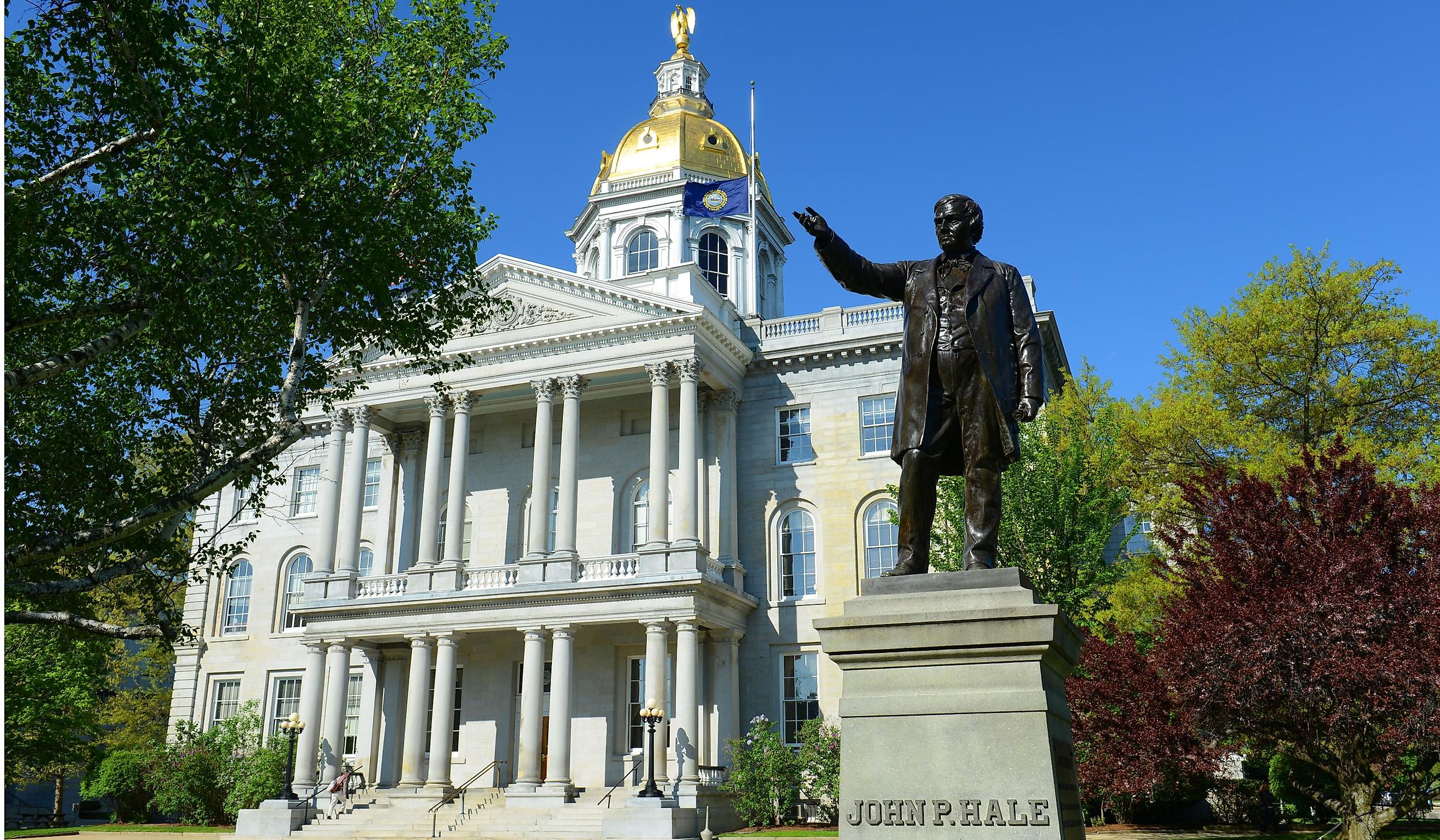
6 Towns in New Hampshire With Rich History
New Hampshire is a state located within the New England region. Massachusetts is situated to the south of New Hampshire, and Vermont is directly west. New Hampshire was one of the first colonies to declare independence from the British on January 4, 1776. By June 21, 1788, New Hampshire was admitted into the United States.
Many small towns play vital roles in the New Hampshire Story. A stop at Concord will take you to the Mcaullife-Shepard Discovery Centre. The building serves as a commemoration of two American Pioneers in Outer Space. Also, the town of Lincoln is home to the "Old Man of the Mountain" at Franconia Notch State Park. Discover towns in New Hampshire that have a rich history.
Portsmouth

Portsmouth, New Hampshire, is located in Rockingham County. In 1623, the region was first established as a fishing settlement along the Piscatagua River. In September 1905, then-president Theodore Roosevelt held negotiations for the Treaty of Portsmouth within the locale. This treaty ended the Russo-Japanese conflict, earning Roosevelt a Nobel Peace Prize.
The Strawberry Banke Museum tells the story of the first English settlement within the region. In 1958, citizens began work to collect the original history of the settlement. By 1965, the Museum was first opened to the public. Today, visitors can travel past fully restored households. A trip here increases your knowledge of the life of citizens from that time.
In 1781, John Paul Jones resided in Portsmouth while supervising the construction of a navy vessel. Jones is a heroic figure from the American Revolutionary War. His moment of glory came in 1779, when, against all odds, Jones led his ship to victory against a powerful English warship. After undertaking significant gunfire, Jones was asked whether he wanted to surrender. He responded, saying, "I have not yet begun to fight." In 1920, Jones House was taken over by the Portsmouth Historical Society, and the building became home to generations of town history.
The USS Albacore is a historic vessel for its time. Commissioned in 1953, the Albacore was primarily tasked with testing potential design upgrades. In 1966, the Albacore broke the world record for fastest traveling speed at 40 miles per hour. Decommissioned in 1972, efforts from Portsmouth residents were successful in housing the Albacore as a display. By 1986, the Museum was first open to the public, allowing visitors to explore the vessel.
Lincoln

Set on the slopes of the White Mountains is the town of Lincoln, New Hampshire. In 1782, Lincoln was officially established, and for a century, it primarily served as a tourist spot. In August 1892, James Henry arrived in town, moving his logging industry into the area. He was vital in progressing Lincoln forward, helping build its first hospital, boarding houses, post offices, and churches.
Franconia Notch State Park is known as the location of "The Old Man of the Mountain." The structure was first discovered in 1805 and was a topic of admiration until it collapsed in 2003. It has been written about by famous voices Nathaniel Hawthorne and Daniel Webster. The Park is also home to plenty of other activities, whether it is a day fishing at Echo Lake or hiking through the geological wonder of the Flume Gorge.
Flume Gorge was first discovered in 1808 by 93-year-old Jess Guernsey. In 1886, the Flume Covered Bridge was built to explore the area and has been maintained ever since. Visitors can witness the wonders of geological evolution and the majestic natural views of waterfalls and mountains.
Berlin

Berlin, New Hampshire, is located in Coos County along the Androscoggin River. Railroad development was brought to Berlin in 1852, allowing for the availability of new industries. The Berlin Mills Company would subsequently be formed by 1868. By 1930, the population would be as high as 20,018. This would mark the historical peak Berlin would reach in its history.
In 1853, The Brown House served as a residency for employees of the H.W Winslow Company. By 1968, it became the house of businessman William W. Brown. Today, the land is a museum showcasing the time of Brown and his family. The rooms within the house are home to period-relevant artifacts. There are also exhibitions of the Logistics industry, which played a vital role in Berlin's economic growth.
The Moffet House Museum and Geneology Centre serves as a local time capsule. Everything a researcher needs to know can be found here, from archival material to memorabilia.
Just North of Berlin lies the Nansen Ski Jump. Constructed in 1936, the jump had a 171-foot steel frame tower and a 310-foot runway. It was home to many major skiing competitions, such as the first-ever Olympic trials in 1938.
Exeter

Exeter, New Hampshire, is a city situated in Rockingham County. The history dates back to 1638, when the settlement was first created. It was meant as a colony for religious exiles. The town is the birthplace of famous sculptor Daniel Chester French. His most iconic creation is the iconic statue of Abraham Lincoln at the Lincoln Memorial in Washington, D.C.
Founded in 1991, the American Independence Museum is a place to study the story of the Revolutionary War. Historians can explore the buildings located on the campus. There is the Ladd Gilman House, which served as the state treasury during the war. There is also Folsom Tavern, which was visited by George Washington in November 1789.
Established in 1781, Phillips Exeter Academy has met the academic needs of students for over two centuries. Notable Alumni of this institution include author Gore Vidal and the founder of Facebook, Mark Zuckerberg. Today, the institution offers 450 courses in 18 subject areas for its over 1000 students.
The Powder House was created in 1771 as a munitions storehouse. It was used throughout early American History. During the Revolutionary War, captured powder from the British was stored at Powder House and used at the battle of Bunker Hill. In 1812, the Governor of New Hampshire approved legislation for purchasing a supply of powder lead and flints for the state's usage. In 1999, Powder House Point was refurbished, and it is still standing today.
Dover

Dover, New Hampshire, is located in Strafford County along the southeastern coast. First established in 1623, Dover is the seventh Oldest American Settlement. Throughout its history, Dover has been known for its industrial development. By the 19th century, they were a leading manufacturer of Cotton. The town is also the birthplace of American Football Head Coach Chip Kelly.
Garrison Hill Tower is an observational overlook of the coastal region of the state. First built in 1880, the tower was named Haley's and Ham's Outlook. There was a telescope to view nearby Mount Washington and a small adjoining restaurant. Following a fire that destroyed the first tower, a second tower was completed by 1913. This building would stay up until the 1990s, when it was deemed unsafe. In 1994, a third tower was completed, and it still stands today at 76 feet tall atop Garrison Hill.
The Michael Reade House is a pre-industrial era building. It was the home of Michael Reade, one of the early Irish Immigrants to the American Colonies. Reade was an ambitious businessman who made a lot of profit from real estate and lumber exporting. By 1780, Reade had finished constructing his house. The building represents a different time in Dover's History. It shows a neighborhood that, at one point, was home to many high-class houses, most of which were destroyed by the expansion of the mill industry. By 1980, the house was listed on the National Register of Historic Places.
The First Parish Church is the oldest in the state of New Hampshire and one of the oldest in America. Noteworthy Pastors have preached at First Parish throughout its history. Reverends David Rood and Jeremiah S Young were known for their stances in opposition to the slave trade. The church was also addressed in 1841 by abolitionist Frederick Douglass. In 1835, architect Benjamin Morrill completed the construction of a steeple clock for the church. Today, the church is still active and fulfilling its mission of serving God and its community.
Concord

The city of Concord is situated inside Merrimack County. The settlement was established in 1733, initially under the name Rumsford, in the province of Massachusetts. However, by 1765, the town was relocated within the borders of New Hampshire and renamed Concord. In 1808, Concord was named the state capital, a position it still holds today.
The Pierce Manse was the residence of Franklin Pierce before being elected the 14th president of the United States in 1852. During this time in his life, Pierce operated as a practicing Lawyer. Following his career in Politics, Pierce returned to Concord, a location where his life ended. In 1971, a volunteer organization saved the house from demolition and has maintained the structure since then.
The McAuliffe-Shepard Discovery Centre is dedicated to the legacy of pioneers in the story of space travel. Before her trip on the 1986 Space Shuttle Challenger, Christa McAuliffe was a teacher in Concord. In 1984, out of over 10,000 applications, Mcauliffe was chosen to be the first private citizen to enter outer space. The plan was for her to be able to broadcast lessons to her students while on the space shuttle. While she would not be able to achieve that goal, her legacy is commemorated at the Mcauliffe Shepard Discovery Centre.
Alan B Shepard, a resident of East Derry, New Hampshire, was given the privilege of being one of the first American astronauts in Outer Space. On May 5, 1961, Shepard reached an altitude of 115 miles, successfully achieving his mission. Over a decade later, in 1971, Shepard took a further step, completing a walk on the Lunar Surface. At the end of his walk, he swung at two golf balls. Today, visitors to the Mcauliffe-Shepard Museum are greeted by two floors of exhibits. These exhibits are dedicated to teaching the science of space travel and the solar system.
Built between 1816 and 1819, the New Hampshire State House is the oldest continuously used statehouse in the United States. In 1818, a huge gold-painted wooden eagle was raised to the top of the structure. In 1864, the building underwent major renovations as it was too small for the state government. The cost for the renovations was around $200,000. Today, statues from John Stark to President Franklin Pierce surround the premises of the building.
Being one of the oldest American States, New Hampshire is rich in history. In the town of Portsmouth, visitors can learn the history of the historic Strawberry Banke settlement. The town of Exeter is also a feature of American History. The Independence Museum is dedicated to the legacy of Exeter during the Revolutionary War. These are only some of the stories that make New Hampshire a place worthy to see. If you want to learn more, you will have to book your tickets now. This great state awaits you.











